The GermGuardian AC4825 and Blueair Blue Pure 411 are huge rivals in the air purifiers market. Both devices are minimalistic without any advanced functions or features. However, that did not stop AC4825 from becoming one of the GuardianTechnologies best-selling models. On the other hand, Blueair is famous for its innovative design and unique pre-filter.
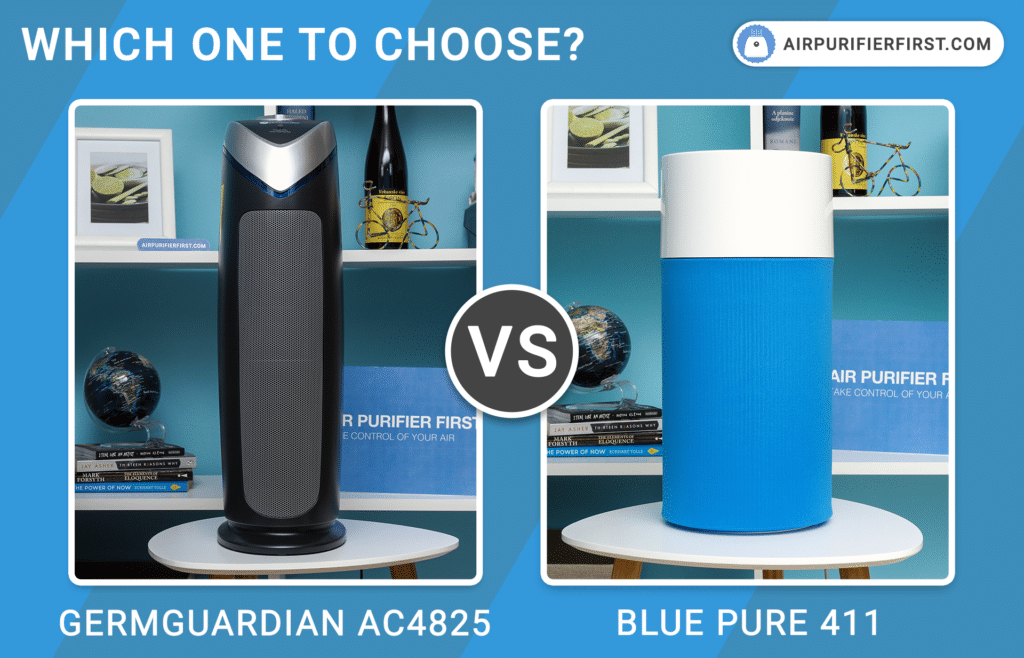
Table of Contents
The GermGuardian AC4825 is intended for 167 sq. ft. rooms, while Blue Pure 411 is for 161 sq. ft. rooms. Both devices are focusing on identical room sizes, and because of that, customers are challenged by which one to get. Because of that difficulty, I will compare these two devices, check test results, and then decide which I think is a better device.
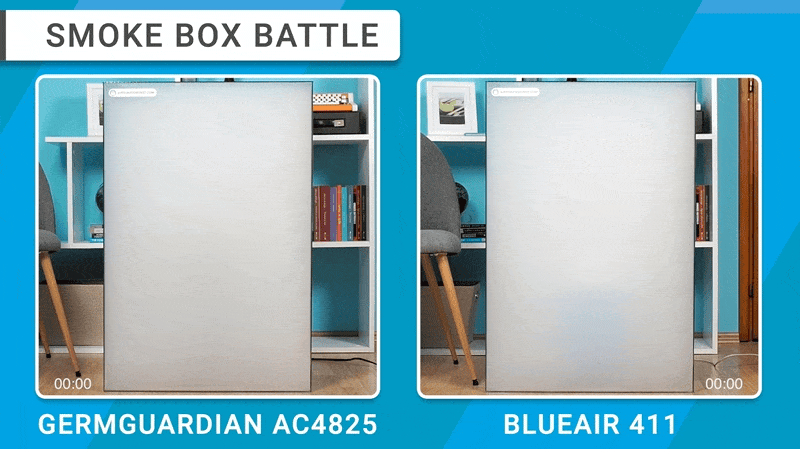
- GermGuardian AC4825 – is one of the most popular air purifiers on the market. It covers rooms up to 167 sq. ft., has a UV-C light, and comes with a 3-year warranty.
- Blueair 411 – is a pure minimalistic air purifier that covers rooms up to 161 sq. ft. It has a washable pre-filter, has a 10W power, and is a very stylish air purifier that will fit in almost any ambiance.
*If you click any of these links and make a purchase, we earn a commission at no additional cost to you.
GermGuardian AC4825 Vs Blueair 411 Specifications
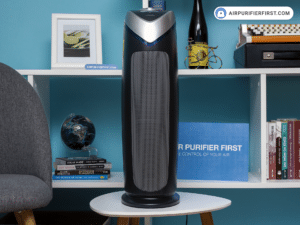 |
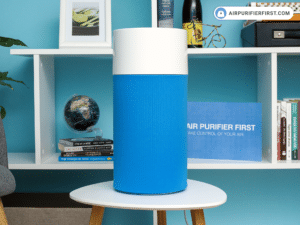 |
|
| Manufacturer | GermGuardian | Blueair |
| Model | AC4825 | Blue Pure 411 |
| Dimensions | 9 x 5.5 x 22 inches | 8 x 8 x 16.7 inches |
| Weight | 8.55 lb | 3.35 lb |
| CADR | Smoke 108, Dust 118, Pollen 125 | Smoke 105, Dust 120, Pollen 120 |
| Coverage | 167 sq. ft. | 161 sq. ft. |
| Filters | Pre/Charcoal filters and True HEPA filter | HEPA + Carbon Filter, Washable Pre-filter |
| Filter Replacement Indicator | ||
| Filter Longevity | 6-8 months | 6-8 months |
| Power Consumption | 55W | 10W |
| Timer | ||
| Sleep Mode | ||
| UV-C Light | ||
| Certifications | Energy Star Verified, AHAM | Energy Star Verified, AHAM |
| Warranty | 3-year | 2-year |
| In-Depth Review | GermGuardian AC4825 | Blueair 411 |
| Price | Check Price on Amazon | Check Price on Amazon |
GermGuardian Vs Blueair Features
Both devices have some identical functions. Both of them have a filter reset indicator, which will let you know when the filter needs replacement. As well both of these lovely air purifiers use three speeds.
Controls
The GermGuardian AC4825 uses a hand-operated mechanical wheel to control fan speed. Below the mechanical wheel is the UV button used to turn the UV-C light on or off and reset the “filter reset indicator.”
The Blue Pure 411 uses a single button for complete device control. This button is used to control the fan speed and to reset the “filter reset indicator.”
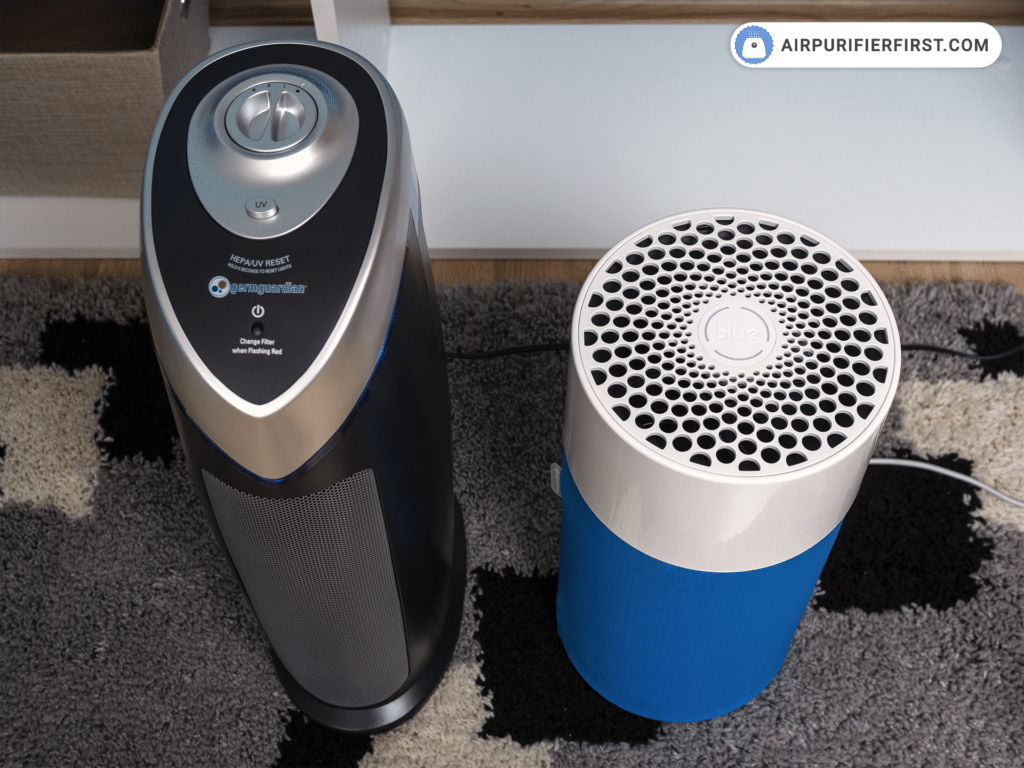
Device control is equal on both devices. The difference is that the AC4825 uses a mechanical wheel, and the Blue Pure 411 uses a single button. GermGuardian can also be used via a smart plug.
UV-C Light
The GermGuardian AC4825 uses a 5W UV-C light bulb. This light helps against germs. The downside of this light is the location. It is located on the upper side of the device, so the air is not kept long enough in front of the UV-C light, and the full potential is not applied. It would be better if the UV-C is placed someplace in the center of the device.
Personalized Pre-Filters
The Blue Pure 411 offers the ability to personalize pre-filters. It is possible to pick one of the suggested colors: Dark Shadow, Diva Blue, Buff Yellow, Crystal Pink, or Lunar Rock.
Airflow
The GermGuardian AC4825 and Blue Pure 411 are tower air purifiers. However, the airflow of the device is different.
With the GermGuardian AC4825, air enters from the rear, after which it is filtered through a pre-filter, carbon filter, and True HEPA filter. Part of the air comes in contact with the UV-C bulb. The filtered air exits through the grilles on the front of the device.
With the Blue Pure 411, the air inlet is located on the unit’s bottom, occupying two-thirds of the device. Air enters from all sides. The opening is 360 degrees wide. The air is filtered through a pre-filter, then through a True HEPA filter, and finally through a carbon filter. After that, air comes out on the upper side of the device.
GermGuardian AC4825 Vs Blueair Blue Pure 411 Video Comparison
Filtration Technology
The GermGuardian AC4825 uses 4-in-1 filtration, with the primary filter being a True HEPA filter. The first stage of filtration is pre-filter. The second stage is the charcoal filter. The third stage is the True HEPA filter. The final stage of filtration is UV-C Bulb.
The Blue Pure 411 uses a HEPA filter, not a True HEPA. Blue Pure 411 uses 3-in-1 filtration. The first stage of filtration is a pre-filter, the second stage is the HEPA filter, and the third stage is a carbon filter. The Blueair 411 filter is bigger than the filter at GermGuardian. Both devices use a fibrous filter covered with carbon.
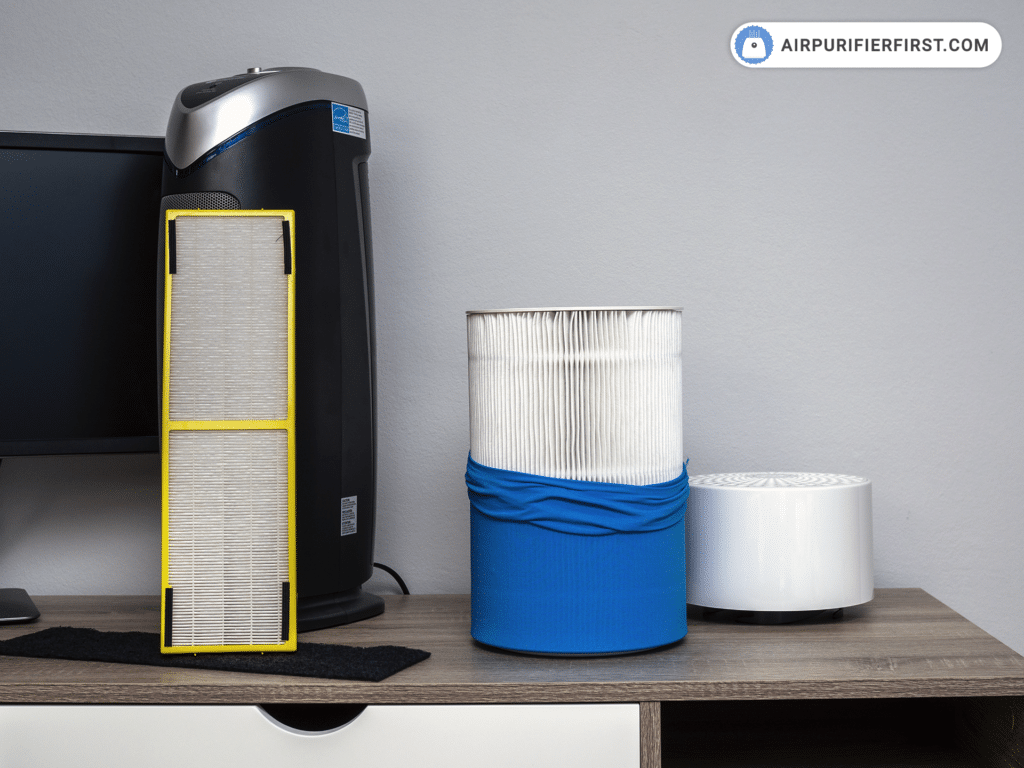
The GermGuardian AC4825 uses an additional filtration stage, UV-C light. UV-C light destroys germs and mold spores. Both devices have a filter reset indicator that will notify the user when it is time to replace the filter.
How to Replace Filters?
With both devices, the filter replacement is needed on average between every 6-8 months. With the GermGuardian AC4825, the light bulb change is required on average every 12 months.
Noise
What I don’t like about both devices is that they don’t have “Sleep Mode.” I especially miss the sleep mode option with the GermGuardian model, which is much louder at first speed than the Blueair.
The Blue Pure 411 is as quiet in first gear as some other devices in sleep mode. I proved it on myself because I fell asleep in the room without any problems while the Blueair 411 was working smoothly.
The situation is reversed at third speed. The GermGuardian is much quieter than the Blueair 411 at third speed. The third-speed Blueair 411 produces a loud and strange sound, and it is challenging to stay in the room while the device is running at the third speed. The table below shows the volume ranges of both devices.
| Product | Noise Range (dBA) |
|---|---|
| GermGuardian AC4825 | 46.7 – 54.2 dBA |
| Blue Pure 411 | 40.6 – 67.5 dBA |
Performance
I tested the devices in various situations and locations. Below I will show the most exciting tests. In all the tests, a third speed was used.
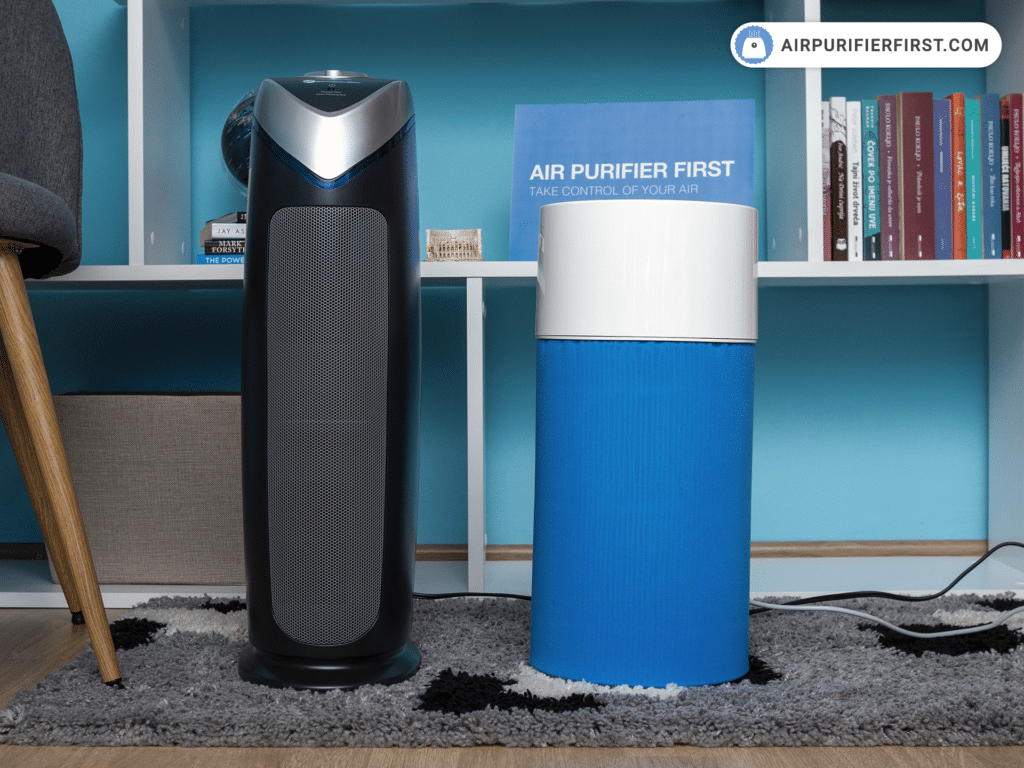
194 sq. ft. Room Tests
In this room, the Blue Pure 411 improved air quality by about 95% in 60 minutes while working at third speed, lowering the AQI from 133 to just 6. In the same period, GermGuardian AC4825 improved air quality by about 92% under the same conditions. Blue Pure 411 did better in this test. I guess the size of the filter is the reason for that. However, it is essential to mention that both devices improved air to a quality that is better than recommended.
194 sq. ft. Room
* Data measuring time is 60 minutes.
320 sq. ft. Room Tests
The GermGuardian lowered the AQI from 80 to 8 in 60 minutes, improving air quality by about 90%. Besides, I repeated the test, but this time with the UV-C light on, GermGuardian was somewhat more efficient this time, which improved the air quality by about 91%.
Blue Pure 411 improved air quality by about 90% under the same conditions.
The results in this room do not deviate much. Both devices did a great job and drastically improved the air quality in the room.
320 sq. ft. Room
* Data measuring time is 60 minutes.
Operating Costs
The GermGuardian AC4825 has a power of 55W. This includes the 5W used by the UV-C light bulb when turned on.
Blue Pure 411 is a far smaller consumer; its power is only 10W. Honestly, I was surprised how a device of such low power can make such good results. GermGuardian is a much larger consumer than the Blue Pure 411.
The AC4825 will cost you about $ 3.8 at the third speed in a month of operation, while Blue Pure 411 will cost you less than $ 1 in a month of operation, also at the third speed.
| Product | Wattage Range (W) |
|---|---|
| GermGuardian AC4825 | 30.8 – 43.1 W |
| Blue Pure 411 | 0.3 – 7.6 W |
In addition to the massive difference in power consumption, there is also a much larger difference in filter replacement price. In this segment, too, Blue Pure proved to be a better choice, as replacement filters for this device are cheaper.
On an annual basis, when we consider electricity consumption and the filter replacement price, the GermGuardian AC4825 will cost you several times more.
Which One Does It Better?
These devices are, in fact, very similar. Both devices are tower based. Comparable dimensions, equal airflow, and both of them are intended for rooms of similar sizes. GermGuardian AC4825 is made for rooms of 167 sq. ft., while the Blue Pure 411 is designed for rooms up to 160 sq. ft.
However, the comparison is not equal in almost any test, and because of that, Blue Pure 411 is the winner.
There are multiple reasons. Blue Pure did a much better job in my tests than GermGuardian. The Blue Pure 411 is several times more affordable to maintain. In addition to being several times smaller than the consumer, replacement filters for Blueair are also cheaper.
The only disadvantage that Blueair has when I compare it to the GermGuardian model is that it doesn’t have a True HEPA filter.
For the above reasons and many others discussed in the article, my suggestion is to buy the Blueair Blue Pure 411 air purifier.
Leave a Reply